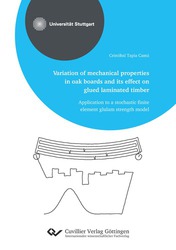| Departments | |
|---|---|
| Book Series (96) |
1378
|
| Nachhaltigkeit |
3
|
| Gesundheitswesen |
1
|
| Humanities |
2363
|
| Natural Sciences |
5406
|
| Mathematics | 229 |
| Informatics | 319 |
| Physics | 980 |
| Chemistry | 1363 |
| Geosciences | 131 |
| Human medicine | 243 |
| Stomatology | 10 |
| Veterinary medicine | 108 |
| Pharmacy | 147 |
| Biology | 835 |
| Biochemistry, molecular biology, gene technology | 121 |
| Biophysics | 25 |
| Domestic and nutritional science | 45 |
| Agricultural science | 1004 |
| Forest science | 201 |
| Horticultural science | 20 |
| Environmental research, ecology and landscape conservation | 148 |
| Engineering |
1791
|
| Common |
98
|
|
Leitlinien Unfallchirurgie
5. Auflage bestellen |
|
Advanced Search
Variation of mechanical properties in oak boards and its effect on glued laminated timber (English shop)
Application to a stochastic finite element glulam strength model
Cristóbal Tapia Camú (Author)Preview
Extract, PDF (130 KB)
Table of Contents, PDF (82 KB)
The renewable material wood and hereof derived structural engineered wood products (EWPs) is widely acknowledged as being the major pillar of sustainable building constructions. Due to an increasing availability and high mechanical performance the wood resource hardwoods has been gaining traction for the use in EWPs, typically dominated by softwoods. Wood, being a naturally grown material, exhibits a pronounced variation in its mechanical properties, presenting marked differences not only between species, but also between individual trees and locally throughout the stem of each tree. Glued laminated timber (GLT) reduces this variation by vertical glue-stacking previously finger-jointed boards to form a highly homogenized wooden beam. This configuration reduces considerably the variation of the observed global mechanical properties of GLT with respect to the individual boards. However, the rather complex material composition of GLT prohibits the derivation of an analytical relation between local (e.g. intra board and finger-joints) and global properties, thus numerical approaches need to be applied. This work addresses the need for an improved understanding and modeling approach of the variability of stiffness and strength along and between boards, and the resulting impact on the size-effect of GLT made of oak.
| ISBN-13 (Hard Copy) | 9783736975880 |
| ISBN-13 (eBook) | 9783736965881 |
| Final Book Format | B5 |
| Language | English |
| Page Number | 228 |
| Lamination of Cover | matt |
| Edition | 1. |
| Publication Place | Göttingen |
| Place of Dissertation | Stuttgart |
| Publication Date | 2022-03-23 |
| General Categorization | Dissertation |
| Departments |
Science of wood and technology
|
| Keywords | glued laminated timber, glulam, GLT, hardwoods, oak boards, Quercus robur, intra-board tensile strength variation, stochastic FEM, glulam strength model, size effect, length effect, survival analysis, autoregressive model, serial correlation, numeric simulations, localized mechanical properties, fracture mechanics, energy dissipation, Brettschichtholz, BSH, Laubhölzer, Eichenbretter, Quercus robur, Zugfestigkeitsvariation entlang des Brettes, stochastisches FEM, BSH Festigkeitsmodel, Größeneffekt, Längeneffekt, Ereigniszeitanalyse, autoregressives Model, Autokorrelation, Numerische Simulationen, lokale mechanische Eigenschaften, Bruchmechanik, Energiedissipation, nachwachsende Rohstoffe, renewable materials, Holzprodukte, wood products, Holzressource, wood resource, Keilzinkenverbindungen, finger-joint, holzbasierte Bauprodukte, wood-based building products, softwoods, Nadelhölzer, Biegefestigkeit des GLT-Trägers, Bending strength of GLT beam, Druckfestigkeit der Bretter, compressive strength of boards, dynamische MOE, dynamic MOE, Likelihood-Funktion, Weibull- und Beta-Regressionsmodelle, Weibull and Beta regression models, AR-Modell, AR model, Zugbeanspruchung, tensile conditions, lichtes Holzsegment, clear wood segment, Elastizitätsmodul, modulus of elasticity, Holzindustrie, timber industry, Schnittholz, Mechanically Graded Lumber, Sprödbruch, brittle fracture, Biegefestigkeit von Brettschichtholz, Klimawandel, climate change, Vollholz, solid timber |








